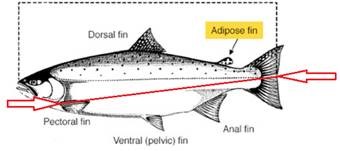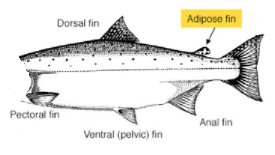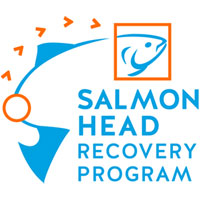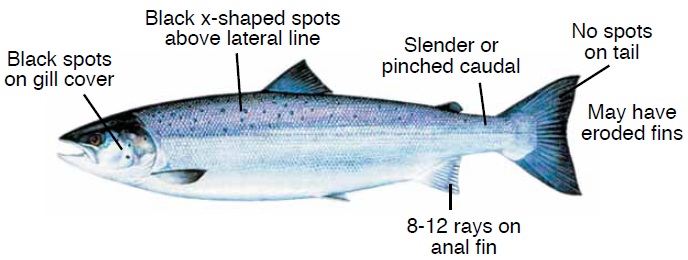Salmon fishing information
General reminders
Know before you go:
- Always check the latest closures and restrictions for your area. In many areas of British Columbia, fishing is not allowed or is restricted; check the size and mark specific regulations for salmon species
- Identify your catch using three characteristics
- Mark status for Coho and Chinook: if your Coho or Chinook salmon is a hatchery-marked fish, it will have a healed scar in place of the adipose fin. This is also referred to as an adipose fin-clipped fish. Unmarked fish still have an adipose fin present.
- You must release incidental catch alive to the place where you caught it, in a way that causes the least harm to the fish
- Fishers are encouraged to participate in the Salmon Head Recovery Program (1-866-483-9994) by labeling and submitting heads from hatchery-marked Chinook and Coho to Head Depots. You will be contributing necessary information for stock assessment and management decisions to protect stocks at risk and guide sustainable fisheries along the west coast of Canada and USA.
- It is illegal to wilfully foul hook a salmon. If you accidentally foul hook a salmon in the ocean, you can keep it. If you foul hook a salmon, wilfully or accidentally, in any lake or stream, including the tidal parts of coastal streams, you must release it immediately
- All retained Chinook must be recorded immediately upon retention. You may record catch details on your paper licence, your National Recreational Licensing System (NRLS) catch log or the FishingBC app catch log. Catch records must be available for immediate inspection, either on your licence, or in your NRLS or FishingBC account using your mobile device. Moving out of cell range? – take screenshots of your NRLS or FishingBC catch records.
- Overall length (head-on) - is measured from the tip of the nose to the fork in tail. Head-off length - is measured between the two arrows shown – from the base of the pectoral fin at its most forward point to the fork in the tail

- Note: Length measurements are taken with a flat ruler or tape (and not curved around the body of the fish)
Gear Restrictions
Gear restrictions
Allowable gear is subject to in-season changes. Always check the latest closures and restrictions for the area where you are fishing.
- In tidal waters there’s no limit to the number of fishing rods and lines you can use, except in the tidal water portions of rivers and streams (including the Fraser River). In the tidal water portions of rivers and streams, and all freshwater rivers and streams, there is a limit of 1 rod or line per angler. In lakes you are restricted to 1 rod or line, except if you are alone in a boat on a lake. In that case you may fish with 2 rods or lines.
- Only a barbless hook may be used for all salmon and sea-run trout fishing. Partially crimped barbs are not allowed; barbs must be crimped flat against the shaft.
- A treble barbless hook is acceptable in most tidal water areas, except as noted below:
- In certain tidal portions of coastal rivers and other specific areas, special management measures are in place requiring a barbless hook having only 1 point (i.e. a treble hook may not be used), and/or the hook to be a certain size. Check the regulations for the area you are fishing before you go, including the Conditions of Licence.
- In tidal waters it is illegal to angle with a fishing line that has more than 1 hook, artificial lure or artificial fly attached, with the following exceptions:
- in the tidal waters of the Fraser River, where you may fish with 2 hooks, artificial lures or artificial flies (on 1 line);
- when bait fishing, you may attach multiple hooks to hold a single piece of bait as long as the hooks are not arranged to catch more than 1 fish (all tidal waters).
- It is illegal to fish with a fixed weight (sinker) greater than 1 kg except on a downrigger line, in which case the fishing line must be attached to the downrigger by a release clip. In certain areas special management measures are in place requiring less than 1 kg; check the regulations for the area you are fishing before you go, including the Conditions of Licence.
- When an area is restricted to fly fishing only, only an artificial fly may be used, and you may not attach a weight or float to the line.
- It is illegal to angle or sportfish for salmon with nets, including dip nets, minnow nets, gillnets or cast nets.
- Be aware of hook and line, downrigger and trap gear entanglement risks in the vicinity of the UVIC Venus project in Pat Bay, Saanich Inlet, and other areas. For more information, visit: http://www.oceannetworks.ca/installations/notice-mariners
Catch and release tips
Practice safe and responsible release techniques to ensure salmon survival.
Do:
- Use only barbless hooks when fishing for salmon (mandatory)
- Use large lures or artificial baits to reduce incidental catch
- Bring fish in as quickly as possible
- Use a soft knotless mesh net to minimize scale loss
- Support the fish when lifting by placing one hand around the base of its tail and the other under its belly
Don't:
- Touch or handle a fish by its gills
- Lift a fish by its tail
Tips for release:
- Handle fish securely, immobilizing while removing the hook, and release to the water quickly
- Smaller salmon (under 30 cm): unhook it at the water surface to minimize handling
- Larger salmon (over 30 cm): Handle securely, bring onboard, remove the hook quickly and release
- Use needle-nose pliers or a surgical hemostat to remove hooks
- If the fish is hooked deep inside the mouth, cut the line as close to the hook as possible and leave it in. The hook will erode in time
- Release the salmon at a 45° angle with the head pointing down and just above the waterline
- If the fish is exhausted, revive it in the water by keeping a grip on its tail; move it back and forth slowly to increase water flow over the gills; wait until it is strong enough to swim out of your hands
Packaging and transporting
Fishers are reminded that they may not retain or transport more than their individual Possession Limit for any species, nor more than any aggregate limit.
The following requirements apply until a fish is prepared for immediate consumption, or the fisher arrives at home, or the fisher delivers their fish to a registered processing service.
If you clean or package your fish, note that regulations require that the species, number, and size of the fish can be readily determined to make sure your catch complies with Daily and Possession Limits, including size and mark specific regulations. For all salmon species, never remove the skin.
If filleted, one complete/intact fillet from one side of the fish including the pectoral fin and the tail fin must be retained. In addition, for Chinook and Coho, the adipose fin or the healed scar showing the hatchery mark must be retained on the same fillet. (See diagram under General Reminders tab.)
When packaging your salmon catch, heads may be removed per the following requirements:
- For Chinook and Coho, overall length size limits are applied according to size limits shown in the Sport Fishing Guide for the area and subarea where they are retained; equivalent head-off size limits are as shown in the Conditions of Licence.
- For Pink, Chum and Sockeye, the head and tail must remain attached, unless the length with the head off is equal to or greater than the minimum legal size of that species for the waters in which it was caught.
- See the diagram under General Reminders tab for guidelines on measuring head-on and head-off lengths
For all salmon species:
- Never remove the skin
- Always leave the tail attached so species can be determined.
- if filleted, one complete/intact fillet from one side of the fish retaining the pectoral fin and the tail fin must be retained.
For Chinook and Coho, additionally:
- the adipose fin or the healed scar showing the hatchery mark must be retained
If necessary the other fillet can be cut into two pieces. All the fillets should be placed side by side in one bag making it obvious that they represent one fish, and the bag must be clearly labelled with:
- the number and species of salmon - e.g., "one Chinook"
- the number of fillets – e.g. "three fillets"
- the angler's name and fishing licence number”

One fillet must retain the Pectoral fin and tail fin.
For hatchery Chinook and Coho, there will be a healed scar in place of the Adipose fin – this must be retained on the fillet with the Pectoral fin and tail fin.
Missing adipose fin? Submit the head for Salmon Science.
Fishers are encouraged to participate in the Salmon Head Recovery Program (1-866-483-9994) by labeling and submitting heads from hatchery-marked Chinook and Coho to Head Depots. You will be contributing necessary information for stock assessment and management decisions to protect stocks at risk and guide sustainable fisheries along the west coast of Canada and USA.
- Fishers are required to ensure that proof of the healed scar remains clearly distinguishable after packaging by leaving the portion of the fish that contains the scar on the fillet with the pectoral and tail fins intact. The healed scar will identify the fish for enforcement officers as a hatchery-marked fish.
Head-off length equivalents support participation. Fishers are required to leave the portion of the fish that contains the pectoral fin and the tail fin intact. The head-off pectoral fin to tail measurement will be used by enforcement officers to assess compliance to minimum or maximum sizes if you remove the head from Chinook or Coho.
When steaking a salmon, leave the steaks connected by a piece of skin; in addition, the tail must remain connected to the skin.
When packaging salmon for guests, lodges and charter operations are to clearly provide the following information on the outside of the transport box.
- the name of angler and fishing licence number; only one name per container
- the number of fish by species and number of packages. For example, the label on the outside of the cooler should state, in the case of two packaged Chinook or two packaged halibut: "2 Chinook - 2 packages", or "2 halibut - 8 packages"
When individuals are transporting or shipping fish they must package their fish separately and only have one name per package. However, they may share a container. It is recommended that the contents (number of fish, species, and number of packages) be listed on the outside of the container to facilitate inspection.
It is recommended that you store and transport your catch in sanitized containers and packages intended for food.
Salmon Head Recovery
Salmon Head Recovery
Missing fin? Keep the head!

If you catch a "marked" fish - one with a healed scar in place of the adipose fin (coho or chinook), remove the head and submit it to a Salmon Head Recovery Depot, with a completed sport head label (available at the Depot). Once the head is dissected you will receive information about your catch.
Contact the Salmon Head Recovery Program at 1-866-483-9994 for more information.
Why participate in salmon head recovery?
By participating in the Salmon Head Recovery Program, you will be contributing necessary information to allow for continued sport fishing opportunities.
In some cases, certain hatchery stocks are used to indicate the health of other stocks in the area. Tag recoveries not only help to indicate that stocks are healthy, but also that stocks of concern could be improving.
In addition to marking hatchery salmon, a very small number of wild coho and chinook (less then 5%) are also tagged and adipose clipped to help biologists monitor habitat enhancement projects associated with wild salmon stocks.
It is just as important to turn in heads from terminal or freshwater sites as it is from marine areas. Even though anglers fishing close to hatcheries can be fairly certain of the origin of their catch, data will not be recorded unless the heads from fin-clipped recoveries are turned in. Without the data, the health of the stock and the value of the resource to anglers could be underestimated.
Coded wire tag facts
- A coded-wire tag is a 1mm piece of wire that is laser etched with a unique number. Tags are injected into the nose cartilage of juvenile salmon prior to ocean migration
- Annually, Canada and the United States tag over 50 million juvenile salmon. Fisheries and Oceans Canada applies about 5.5 million tags, using about 5.5 kilometres of wire
- Coded-wire tags allow Canada to fulfill obligations for International Pacific Salmon Treaty initiatives and provide valuable information, including:
- abundance, distribution and survival
- trends for planning next year’s fishing season
- run timing in salt and freshwater areas
Related links
Tagging programs
Salmon tags
We use tagging programs in BC to study the migration and growth of salmon. This involves attaching numbered tags to fish, usually located near the dorsal fin.
The two kinds of external tags you might encounter are:
- Floy tags: brightly coloured, look like a piece of string about five inches long
- Peterson tags: Small round plastic disks.
Report: If you discover an external tag on your catch, report the number along with information on where the fish was caught to your nearest DFO office, or mail it to: Erik Grundmann, Pacific Biological Station, 3190 Hammond Bay Road, Nanaimo, B.C. V9T 6N7.
Should you find a PIT tag, turn it into your local Fisheries and Oceans office and include details of where and when the fish containing the tag was caught.
Atlantic Salmon Watch Program
What is the Atlantic Salmon Watch Program?
The Atlantic Salmon Watch Program (ASWP) is a research program operated by Fisheries and Oceans Canada. The purpose of the program is to study the abundance, distribution and biology of Atlantic salmon in British Columbia and its adjacent waters. The ASWP monitors reports from commercial and sport catches and observations of Atlantic salmon throughout British Columbia. The program relies on recreational and commercial fishers, fish processors, government and independent field staff and hatchery workers to report observations of Atlantic salmon.
How do you distinguish Atlantic salmon from Pacific salmon?
Click thumbnail to enlarge image.
What should I do if I catch an Atlantic salmon?
Keep the fish and report the capture by calling the ASWP toll-free reporting line at 1-800-811-6010. You will be asked where and when you caught the fish and if you wish to donate the fish or part of it for research purposes. Donation is not mandatory but it does provide valuable samples for our scientific study. For whole fish donation, the entire fish, including entrails, should be frozen or kept on ice. Alternatively, the head and a small portion of the back including scales can be preserved. ASWP staff will arrange for transport of the sample.
Report all captures of Atlantic salmon to: 1-800-811-6010 (toll-free).
- Date modified:
